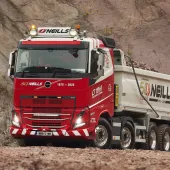Cemex trial industry-first cement discharge system
Unique electric-powered discharge equipment to cut emissions and increase vehicle longevity
CEMEX are trialling an industry-first discharge system for cement, which can be fully powered by electricity to substantially reduce fuel use and subsequent emissions.
The system, the brainchild of a Cemex employee, has been trialled in Cemex’s UK cement operation, where it is said to have performed effortlessly. Not only has the use of electricity to power the discharge equipment cut emissions, but it has enabled a faster turnaround and significantly quieter delivery. Longer-term, vehicle wear and tear are also reduced.
Cemex say the benefit to the environment of incorporating this equipment into a commercial fleet is considerable; the trial has demonstrated a potential saving of more than 4,000kg of CO2 per vehicle per year, as well as 330 gallons of fuel.
Matthew Wild, vice-president of supply chain and procurement for Cemex EMEA, commented: ‘We have been very impressed with the results of the initial trial of the electric discharge equipment in our cement business. Every single delivery that uses this system to discharge cement, rather than the tanker’s own fuel, saves 13.5kg of CO2; if this equipment was used across our fleet over a full year, the difference to our supply chain emissions would be considerable.’
The idea for this new discharge equipment came from Nigel Ponton, national fleet engineer for the UK business. He worked with supplier Gardner Denver to create the system, which is mounted on to the tractor unit and simply requires three-phase connection to pressurize the tank and allow discharge to the silo. This means no additional equipment or investment is needed at the customer’s site.
Mr Wild added: ‘We believe that every member of our workforce plays a role in ensuring we reach our goal of operating as a net-zero company by 2050. The development and trial of this idea demonstrates that nurturing and investing in innovation in your business helps achieve your strategic priorities. Following the successful results of this trial, we are exploring incorporating it across our wider fleet, while also looking at land-based units which can be housed at site.’










